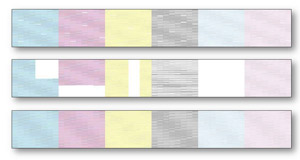 Color management is a process that must be continuously monitored and controlled. At the same time, each facility’s color management strategy is different depending on variables such as substrates, printing techniques, ink sets, and printers.
Color management is a process that must be continuously monitored and controlled. At the same time, each facility’s color management strategy is different depending on variables such as substrates, printing techniques, ink sets, and printers. Since there are so many variables, it’s important to avoid some common mistakes that can affect color reproduction. The following outlines three such mistakes, and proactive measures.
Mistake 1: Not Maintaining Printers Properly
Printer maintenance is key to good color reproduction. If a printer is not working properly, it won’t produce quality color.
You’ll need to know the proper settings for your printer. Each one is different, so there aren’t global setting recommendations. However, dealers and technicians can usually help you figure out what a printer’s “sweet spot” is for quality printing. Having correct settings will reduce wear and tear on the printer.
Another consideration is the environment of the printer. It should be climate-controlled so that the temperature, humidity, and density are consistent. You wouldn’t want to install a printer near a door to the outside that is opened and closed several times a day.
A great way to determine whether your printer is in good printing condition is to perform a daily nozzle check. It’s a quick and easy way to check out the health of your printer. If the check shows nozzles missing, a hard clean might fix the problem.
Mistake 2: Evaluating Color with Only Your Eyes
It can be tempting to rely on our eyes when evaluating color; but we cannot trust our eyes alone. Too many factors can affect how we perceive color.
Some of these factors are physical ones. As we get older, our eyes become frailer and our eyesight less accurate. Our eyes become fatigued at the end of the day. Some of us have degrees of color blindness.
There are also phenomena that occur which can affect how we see color. There’s the concept of adjacency, where a color can look different depending on what other color it’s near. Color can also look different depending on what light source is used for viewing. This is called metamerism.
Then there are problems such as color memory. That’s why we can’t talk about color with words. Royal blue to one person can mean something different to another. Therefore, we use numbers and math to evaluate and talk about color. To do that, we measure color with a device (a colorimeter or spectrophotometer) and use a supportive software to view and assess color mathematically. Using numbers to describe color is more precise and accurate than using words.
There are many measurement devices and software systems, and the right pairing may depend on the type of printing. Talk to a color management expert for advice.
Mistake 3: Not Treating Your Color Management as a Process
 As previously mentioned, a good color management strategy is a process that is maintained and controlled.
As previously mentioned, a good color management strategy is a process that is maintained and controlled. When you buy a vehicle, it is recommended that you get an oil change after a few thousand miles. But that won’t be the only oil change necessary to keep your car in good running condition. If you don’t maintain the car, it will eventually break down. The same is true for a printer and a color management strategy.
To keep a good color management strategy in place, you’ll need to make some decisions. Who will be responsible for maintaining the printer(s)? Who will perform the daily nozzle check? What measurement device and software will you use? Who will be the one using them for verification when a printer drifts?
Color management is about variables. If these common mistakes are avoided and a process is put in place, repeatable and consistent color can be achieved.
 Shelby Sapusek is a color management consultant and CMO of ColorCasters LLC. She grew up in the newspaper industry; working in graphic design and pre-press. She’s been working in the wide-format print industry since 2011. Today, she works with graphic designers, end users and manufacturers to improve their color management skills. To learn more about the color management process, feel free to contact Sapusek at shelby@colorcasters.com.
Shelby Sapusek is a color management consultant and CMO of ColorCasters LLC. She grew up in the newspaper industry; working in graphic design and pre-press. She’s been working in the wide-format print industry since 2011. Today, she works with graphic designers, end users and manufacturers to improve their color management skills. To learn more about the color management process, feel free to contact Sapusek at shelby@colorcasters.com.